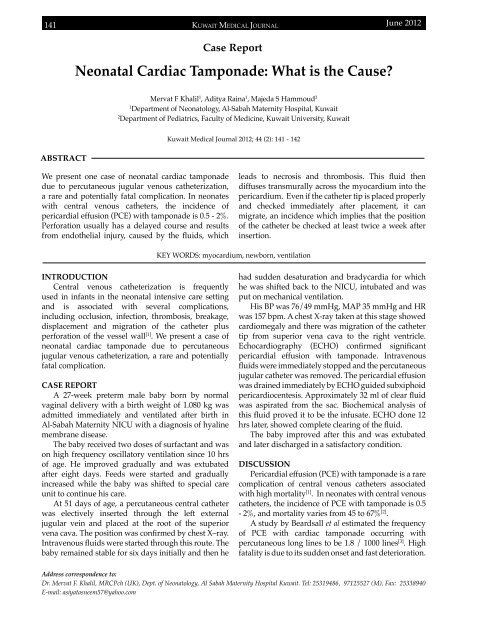Vol 44 # 2 June 2012 - Kma.org.kw
Vol 44 # 2 June 2012 - Kma.org.kw
Vol 44 # 2 June 2012 - Kma.org.kw
Create successful ePaper yourself
Turn your PDF publications into a flip-book with our unique Google optimized e-Paper software.
141<br />
KUWAIT MEDICAL JOURNAL<br />
<strong>June</strong> <strong>2012</strong><br />
Case Report<br />
Neonatal Cardiac Tamponade: What is the Cause?<br />
Mervat F Khalil 1 , Aditya Raina 1 , Majeda S Hammoud 2<br />
1<br />
Department of Neonatology, Al-Sabah Maternity Hospital, Kuwait<br />
2<br />
Department of Pediatrics, Faculty of Medicine, Kuwait University, Kuwait<br />
ABSTRACT<br />
Kuwait Medical Journal <strong>2012</strong>; <strong>44</strong> (2): 141 - 142<br />
We present one case of neonatal cardiac tamponade<br />
due to percutaneous jugular venous catheterization,<br />
a rare and potentially fatal complication. In neonates<br />
with central venous catheters, the incidence of<br />
pericardial effusion (PCE) with tamponade is 0.5 - 2%.<br />
Perforation usually has a delayed course and results<br />
from endothelial injury, caused by the fluids, which<br />
leads to necrosis and thrombosis. This fluid then<br />
diffuses transmurally across the myocardium into the<br />
pericardium. Even if the catheter tip is placed properly<br />
and checked immediately after placement, it can<br />
migrate, an incidence which implies that the position<br />
of the catheter be checked at least twice a week after<br />
insertion.<br />
KEY WORDS: myocardium, newborn, ventilation<br />
INTRODUCTION<br />
Central venous catheterization is frequently<br />
used in infants in the neonatal intensive care setting<br />
and is associated with several complications,<br />
including occlusion, infection, thrombosis, breakage,<br />
displacement and migration of the catheter plus<br />
perforation of the vessel wall [1] . We present a case of<br />
neonatal cardiac tamponade due to percutaneous<br />
jugular venous catheterization, a rare and potentially<br />
fatal complication.<br />
CASE REPORT<br />
A 27-week preterm male baby born by normal<br />
vaginal delivery with a birth weight of 1.080 kg was<br />
admitted immediately and ventilated after birth in<br />
Al-Sabah Maternity NICU with a diagnosis of hyaline<br />
membrane disease.<br />
The baby received two doses of surfactant and was<br />
on high frequency oscillatory ventilation since 10 hrs<br />
of age. He improved gradually and was extubated<br />
after eight days. Feeds were started and gradually<br />
increased while the baby was shifted to special care<br />
unit to continue his care.<br />
At 51 days of age, a percutaneous central catheter<br />
was electively inserted through the left external<br />
jugular vein and placed at the root of the superior<br />
vena cava. The position was confirmed by chest X–ray.<br />
Intravenous fluids were started through this route. The<br />
baby remained stable for six days initially and then he<br />
had sudden desaturation and bradycardia for which<br />
he was shifted back to the NICU, intubated and was<br />
put on mechanical ventilation.<br />
His BP was 76/49 mmHg, MAP 35 mmHg and HR<br />
was 157 bpm. A chest X-ray taken at this stage showed<br />
cardiomegaly and there was migration of the catheter<br />
tip from superior vena cava to the right ventricle.<br />
Echocardiography (ECHO) confirmed significant<br />
pericardial effusion with tamponade. Intravenous<br />
fluids were immediately stopped and the percutaneous<br />
jugular catheter was removed. The pericardial effusion<br />
was drained immediately by ECHO guided subxiphoid<br />
pericardiocentesis. Approximately 32 ml of clear fluid<br />
was aspirated from the sac. Biochemical analysis of<br />
this fluid proved it to be the infusate. ECHO done 12<br />
hrs later, showed complete clearing of the fluid.<br />
The baby improved after this and was extubated<br />
and later discharged in a satisfactory condition.<br />
DISCUSSION<br />
Pericardial effusion (PCE) with tamponade is a rare<br />
complication of central venous catheters associated<br />
with high mortality [1] . In neonates with central venous<br />
catheters, the incidence of PCE with tamponade is 0.5<br />
- 2%, and mortality varies from 45 to 67% [2] .<br />
A study by Beardsall et al estimated the frequency<br />
of PCE with cardiac tamponade occurring with<br />
percutaneous long lines to be 1.8 / 1000 lines [3] . High<br />
fatality is due to its sudden onset and fast deterioration.<br />
Address correspondence to:<br />
Dr. Mervat F. Khalil, MRCPch (UK), Dept. of Neonatology, Al Sabah Maternity Hospital Kuwait. Tel: 25319486, 97125527 (M), Fax: 25338940<br />
E-mail: asiyatasneem57@yahoo.com
















